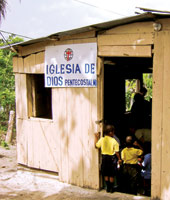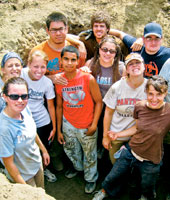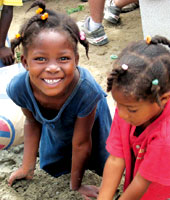 |
|
Autumn 2007 | Volume 30, Number 2
| Features
|
|
|
Fire From Heaven
In Latin America, Pentecostals fuel the rapid spread of Christianity

A crowd packs a church near Santo Domingo while SPU students teach Vacation Bible School. |
A fire falls from heaven! And when the fire has started, it does what it does! Who can stop it? It does what it does!
A stout woman of 60, gray-haired, dressed in a long skirt and modest blouse, holds a microphone directly to her lips and strains her voice to belt out the song. When the fire falls, who can stop it?
She is leading the Pentecostal congregation of Iglesia numero siete (Church number 7) in Santo Domingo, Dominican Republic, where I and nine Seattle Pacific University students are gathered for Sunday morning worship. It is a 90-degree day in June 2007 and more humid than many of the Seattle-based students have ever experienced.
The woman’s eyes are jammed shut. She holds the microphone in her left hand and raises her right in a victorious fist. Who can stop it? It does what it does! She shifts her weight from one foot to another in time with the four different percussion instruments and a keyboard accompanying her. She has been leading this same song for about 10 minutes. Her brow and face are sweaty. It does what it does! It does what it does! Who can stop it? It does what it does!
The song carries us like a river. It flows along, building power until it reaches a crescendo. We hang there a moment as if on the edge of a waterfall. Then we drop over and find ourselves at the beginning of the song again. I look at the students with me. Some are holding up their hands and swaying — they don’t understand the words, but it doesn’t seem to matter. Others are looking around, fascinated, taking it all in.
They’ve heard it before, but now they are learning it in a life-changing way: People worship God differently. Others, like me, are following along intently to our songbook, which has the chorus translated. I look at the words again, and smile as I recognize that every song seems to have something to do with power, fire, or victory. Now this is Latin American Pentecostalism!

The SPU team helped install a water purification system. |
The students and I are nearing the end of our trip. During Spring Quarter, we gathered every Monday evening to study Latin American Pentecostalism for an hour and a half. Students read articles and presented reports on Pentecostalism’s beginnings and its rapid spread around the globe. One author estimated that if you add together the Pentecostals in Latin America, Africa, Asia, and North America, together with the “charismatic” renewal movements in traditional denominations, you could come up with the not-unrealistic number of 500 million Pentecostals worldwide. And this is a movement that only started 100 years ago. We could be witnessing something as momentous as the Protestant reformation.
The past two weeks we have talked with Pentecostal leaders, pastors, teachers, students, and congregations to try to get a firsthand experience to compare with the books. We have also worshiped and worked alongside them. In a sugar cane “Batey” near the border of Haiti, we dug immense holes and then lined them with cinderblock — the structure for two latrines which will help this community deal with its sewage.
As we expected, we return with more questions than answers. But far from leaving us discouraged, we consider this our greatest success. We serve a surprising God who works through complicated people in complex situations.
For instance, many Dominican churches separate men from women in worship, and consider the husband to be the authority and head of the family. Conservative? The same churches have women pastors. I asked Moises Mateo, president of the Iglesia de Dios (MI) denomination, how they arrive at this practice. “Pastoring is a gift,” he tells me and the students. “God gives it to whomever he wants.”
Since I know him well, and he doesn’t mind a little ribbing, I go one step further. “So if I were married to my pastor, then would she have authority over me in church, and would I have authority over her at home?” He slaps his hand on his knee, lets go a boisterous, infectious laugh, and tells me, “Hey, this is a democracy!”
Similarly, the churches adhere to a strict, modest dress code and forbid drinking alcohol, smoking, gambling, and tattoos. Yet the atmosphere in church is far from puritanical (one of our American missionary hosts has earplugs tucked into her Bible cover), and they are constantly laughing.
Neither can you make easy distinctions between what is “indigenous” to the Pentecostalism of Latin America and what is imported from international missionaries. The churches that our students found most authentically “Dominican” — the modest, one-room cinderblock edifices in poor villages — were connected with North American or Puerto Rican denominations. The “rich” church we visited downtown, however, complete with air conditioning, carpet, and PowerPoint, seemed startlingly similar to churches in the United States — except that it was founded by Guatemalans.

"Batey" children join the effort to contruct latrines. |
Why is the Pentecostal church growing in Latin America and all over the majority world? What will the North American church look like if Christianity continues to grow in the United States because of immigration, and not institutional regeneration? What can we learn from Latin American Pentecostals?
For me and our students, the answers to all those questions lie deep in experiences of worship and friendship with Dominican Pentecostals.
The drumbeat slows and with it the woman’s sway. She gives up the microphone and sits down. At the end of the service, as the congregation greets one another, I smile at her, and she gives me a great hug. “Dios te bendiga!” she says. God bless you.
“Amen, amen, y tu tambien,” I reply. Amen, amen, and you also.
I never got her name, but I leave with her voice prophesying in my head, and it remains there: The fire falls from heaven! Who can stop it? It does what it does!
— By Matthew L. Koenig, SPU Associate Director of University Ministries and Minister of Discipleship [mlk@spu.edu]
— Photos by John Keatley and the SPRINT team
Back to the top
Back to Features Home
|
| |
|
 |
 |

|
 |
from the president
Going Global
President Philip Eaton asks the Seattle Pacific community to discuss what “global” means for SPU.
campus
APA Accreditation
SPU’s doctoral program in psychology now in an elite group.
alumni
Street Vision
Hillary Prag '06 gives homeless teens a voice — through a camera lens and Seattle gallery showing.
books, film, & music
Behind the Faces
Four new films may help moviegoers learn to love and understand their global neighbors.
athletics
On the Fast Track
Jessica Pixler received numerous awards as a freshman, including an international gold.
my response
A Banquet of Languages
David Habecker ’93 says knowing multiple languages gave him a new perspective on life — and his faith.
Response art
Forbidden City
Professor Joanna Poznanska and her husband share “Forbidden City,” by a Chinese artist.
|
 |
|
 |